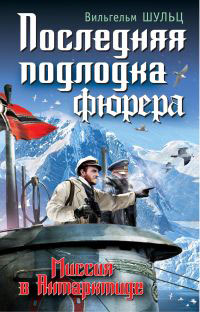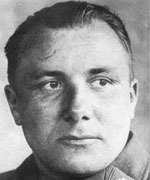The German grasping at the Antarctic
The history of German Antarctic research started at 1873 when Sir Edward Dolman on behalf of the newly founded German Society of Polar Research discovered new Antarctic routes with his ship "GRÖNLAND". Dolman discovered the "Kaiser-Wilhelm-Inseln" at the western entrance of the Bismarck along the Biscoue Islands. Exploring the polar regions, the Germans were already at this time quite innovative, for the "GRÖNLAND" was the first steamship to see the Antarctic ice at all.
Within the next 60 years 2 further expeditionary thrusts took place, and two complete expeditions were fulfilled, namely 1910 under Wilhem Filchner with his ship "DEUTSCHLAND" and 1925 with the special designed polar expedition ship, the " METEOR" under the command of Dr. Albert Merz.
During the recent years before WWII the Germans claimed to hegemony about parts of Antarctica and the wished to possess an own base grew stronger. At this time the Antarctic was not safe due to international treaties like today and a pragmatic proof of Germany´s claim by a single strike to the south pole on the eve of the war seemed to be the best option. Hitler himself was anxious for a foothold in the Antarctic and such a claim could be used pretty well for the National socialistic propaganda and a further demonstration of the uprising "Superpower Germany" . On the other side a new provocation of the Allied had still to be avoided for some time. Germany was - at this time - not completely prepared for the coming war.
As a matter of fact, the idea of a semi-civilian expedition in cooperation with the German national airline company, the "LUFTHANSA" grew up. A civilian covered expedition with truly military and strategic background, a highly political charged balancing act. The command on this strike was given to the polar -experienced Captain Alfred Ritscher, who had already led some expeditions to the North Pole and proved courage and skillness in critical situations. The selected ship was the " MS SCHWABENLAND" , a German aircraft carrier used since 1934 for transatlantic mail delivery by special flight boats, the famous 10t schwere Dornier "Wale" . These "Wales" were mounted on steam catapults on the deck of the ship and could be started and refueled this way easily. This circumstance should proof very well during the expedition. The "SCHWABENLAND" was prepared for the expedition on Hamburg´s shipyards, which cost the huge amount of 1 Million Reichsmark, nearly a third of the complete expedition budget.
Meanwhile, the crew was prepared and scheduled by the German Society of Polar Research precisely .This society also made the sensational step to invite Richard E. Byrd, the most famous American Antarctic researcher. On the mid of November 1938 he arrived in Hamburg and showed the crew and a clearly selected publicity of 84 persons his new Antarctic documentation movie in the Urania of Hamburg. Byrd, who had flown across the south pole as the first human in 1929, was already at this time a living legend, a national hero to the Americans and most of the polar researchers. In 1938 he still was civilian. This invitation to the Germans could have been a typical irony of history, for nearly ten years later exactly this Richard E. Byrd - then in the rank as US NAVY admiral - got the instruction to destroy the secret German Antarctic base 211. To do this, he was given the command of the biggest military force on the Antarctic ice ever seen, 13 ships and nearly 4000 men staff. That mysterious operation which is said to have ended in a catastrophically failure.
But -for now- back to the fact:
The "NEUSCHWABENLAND" left the port of Hamburg on December 17th 1938 heading to the Antarctic on a precisely planned and determined route and reached the ice on January 19th 1939 at 4∞ 15´ W and 69∞ 10´S. The following weeks on 15 flights the "PASSAT" and the "BOREAS" flew across some 600.000 square kilometers and made with their special designed German "Zeiss Reihenmessbildkameras RMK 38" more than 11.000 pictures of the area. The old Norwegian maps from 1931 on these area were renewed, for they proved to be fake. (Could not be different, because the Norwegian expeditions before did never go so deep into the ice from the used Northern landing point). Nearly one fifth of the whole Antarctic area was scanned this way, thus documented for the first time and simultaneous claimed to be German territory. To stress this claim on the outside too, the two planes dismissed several thousands of drop-flags, special metal poles with expedition's insignia on them, the "swastika". The whole territory now got the still valid name: "NEUSCHWABENLAND", referring to a south German region (which is actually not far from me here).
Interestingly, the Expedition seemed to have discovered ice-free areas with even lakes and small signs of vegetation in the mid of the Antarctic occurred. The geologists said that this phenomenon was due hot sources in the ground. Concurrent, the landings points where marked with "prick-flags".
Notes:
1. some newer historians reduce the discovered area to an amount of 325.000 square kilometers. Do not trust these numbers, I have copies of the original flight maps here, revealing the number 600.000 in ancient letters. What could be the reason to reduce this number?
2. Most parts of "NEUSCHWABENLAND" were renamed according to the Antarctic treaty in 1957. Look out for "QUEEN MAUD LAND"., "PRINCESS MARTHA COAST","PRINCESS ASTRID COAST". On the older maps you will still find the original names. Yet, until today still many of the mountains in the northern Antarctic area carry German names like: "MÜHLIG-HOFFMAN-MOUNTAINS", "WOHLTAT-MOUNTAINS", etc. These names were given according to leading Berlin bureaucrats who enabled with their policy the expedition's targets.
In the mid of February, the "SCHWABENLAND" again left the Antarctic. It took two months back to Hamburg and Ritscher carefully used this time to organize the results, maps and photos. Captain Ritscher surprised by the results of the flights, immediately planned after the arrival a second, fully civilian, expedition in use of lighter airplanes with skids. Facing the beginning of WWII, these civilian (!) plans were said to be given up somewhere on October 1939.
Yet, what about the military and strategic option achieved by this strike? Was it wasted resources so far? Today, all historians agree in the fact that the WWII was not accidentally started but pretty well planned from the early 30´s and even before. At least since 1933 the whole German dictatorship tried to gain war fitness within a decade or earlier. In all - and I really mean all - aspects of life: military, "civilian", economic, social, private, resourcing, engineering, foreign policy, and so on, in all aspects the Germans were put straight on their way to war more or less obviously. Pointing to this only aim, the Nationalists abused the typical kind of German correctness and missing sense for rebellious scrutinizing. Nothing was left to chance! And this same method was used in the Antarctic issue, which in my eyes NEVER ended with Ritscher´s return 1938 but went on during the WWII.
Unfortunately, at this point all valid information are vanished. What is left is a scattered puzzle of hints, testimonies and reports which go up to the fifties and which we partially can not verify anymore. So IF the Germans WERE able to build up an Antarctic (underground) base on the results of Ritscher´s expedition, this would be one of the really best covered secrets in German history. No question, German engineers HAD the knowledge to construct something like that as the huge underground establishments of the Nordhausen complex in the Harz as well as Kahla complex at Thüringen and many more prove. Does this you Americans remembers you of something??? The pattern somehow is the same: A lying government / dictatorship and a frightened, blind-held folks willing to obey and believe in what they are fed up with..(see Roswell)
What follows now is the attempt of a chronological
collection of the events and their conclusions as far as they are known to us
today. They all lead to the establishing of the Antarctic base 211 at the end
of war by means of German submarines and flying saucers and to the (failed ?)
attempt to destroy it by the US Navy in 1947.
-
since
1936 |
Evaluation
of the anti-gravity propulsion of a nearly 100% functional flying saucer
going down in the "Schwarzwald" summer 1936 Alternative
hypothesis: Self-developing this propulsion by experiments
of German scientists basing on Viktor Schauberger´s anti-gravity experiments. |
since
1938 |
first unmanned flights with the new (re-)build propulsion. A very special
section of the "Reichsluftfahrtbehörde" gets the project
under its control with the aim to build up antigravity fighters and
troop carriers. The project's name is "HANEBBU"(some
sources also call it the "VRIL "project).
The prototypes are numbered in ascending order. The project has many
setbacks in the first years due to the massive electro-magnetic disturbances
and their interaction with conventional electric components. Although
the propulsion can be handed and used principally, it seems to be nearly
impossible to "drive or fly" these prototypes in sharper angels
than 90∞, thus not usable as fighters. Additionally normal navigation
systems referring somehow to magnetic fields were completely useless
and a special, magnetic independent navigation instrumentation designed,
the celestial guidance system: "Meisterkompass" and "Peiltochterkompass" |
ab
1940 |
Further secret German expeditions to "NEUSCHWABENLAND". As
landing points, there could have been used two of the three marked landing
bays north-west of the "MÜHLIG-HOFFMAN MOUNTAINS" close to
3∞ W and 70∞ S. Those were already documented as landing bays by Ritscher.
|
from
1942/43 on |
Starting the assemblage of the Antarctic base 211. Simultaneously a
second secret base is build up on a high plateau in the South american
Andean. (Argentina ?) |
1942-1945
|
Necessary items for the erection of the bases are continuously transported
on submarines.
Note:
German submarine commanders are highly experienced in the arctic waters
due to the need of delivery of material and people to Germany's northern
arctic bases and civilian research stations. In fact at least 20 well
documented operations have taken place along the arctic until 1945
by means of these submarines. Some of these operations, especially
the later ones, had to be carried out under extreme conditions and
with the permanent threat of contact with the enemy. Besides, on their
way to the south pole, researchers discovered somewhat like a straight
deep submarine trench fitting pretty well for the necessary transportation's. |
Summer
1944 |
The "HANNEBU" series has left the stadium of prototypes
and brought up to 19-25 ships in 2 (or even 3) sizes. "HANEBU
I" is a small vessel, "HANNEBU II" a more supplicated,
larger one. Some reports even hint at "HANNEBU III", which
was designed as a mother ship. If this third type has become reality,
there existed only one single ship. So, the overall transport capacities
are still very limited, due to a quite small diameter of the disks.
Additionally production of ships gets more and more difficult, because
the Allied manage to cut of Germany's raw materials more and more.
Yet "HANNEBU's" manage to disturb some allied bomber raids
over Germany.
Note.
Every allied bomber pilot in the recent years of the war knows the
mysterious threat of the so called "foe-fighters" appearing
and vanishing with incredible speed and causing bright-orange light
phenomenon's and paroxysmal instrumentation failures on all electric
and magnetic parts of the bombers. In no source a direct attack by
these "foe-fighters" is mentioned, they seem to play a completely
defensive role on the late air war over Germany. Although the overall
effect is minimal and has no more influence on the proceed of the
war. |
Winter
1944/45 |
The enormous pressure of the Allied forces the Germans to give up
the big secret underground facilities in Eastern Germany. They Allied
themselves seem to be pretty well informed on these facilities and
overall eager to capture them. There Germans flee and leave back much
material of the HANNEBU project. The attempt to rebuild the construction
zones in the mid of Germany fails.The war is nearly over.
Notes/Quotations
- "...
I have seen enough of their designs and production plans to realize
that if they (the Germans) had managed to prolong the war some months
longer, we would have been confronted with a set of entirely new
and deadly developments in air warfare"
(Sir Roy Feddon, chief of the technical mission
to Germany for the Ministry for Aircraft Production in 1945)
- "When
WWII ended, the Germans had several radical types of aircraft and
guided missiles under development. The majority were in the most
preliminary stages, but they were the only known craft that could
even approach the performance of objects reported to UFO observers.."
(Captain
Edward J. Ruppelt Chief of the US Air Force Project "Bluebook"
on 1956)
|
late
in April 1945 |
A
last convoy of submarine vessels leaves German Harbors with direction
Antarctica and Andean. It is the overall successful attempt to escape
the Allied´s clutches. Among this last convoy there are the U 530
(Captain Otte Wehrmut) and the U977m (Captain Heinz Schäffer).
Note:
The
last visual contact with U977 was on April 26th at Christiansund.
Schäffer´s crew did not reveal anything about the submarine's
destination or load. The vessel vanishes now for nearly 4 months,
before the crew delivers a completely empty vessel to Argentinean
Officials. |
April/May
1945 |
In the same way, leading NS-Officials and technical are evacuated
from Berlin/Potsdam with the HANEBU fleet heading to the meanwhile
completed (?) base 211. The overall transport capacities are quite
limited. |
May
1945 |
The submarine convoy achieves in the southern Atlantic Sea a sea victory
over an Allied unit trying to stop it. This event is under wraps until
today. |
8.Mai
1945 |
Germany's capitulation |
17.August
1945 (!) |
Some submarine crews who are not willing to live in the base or who
perhaps can't be admitted to the base travel to Argentine and hand
over their completely empty submarines.
Note:
Among
those are at documented cases of U530 and U977. High US Navy officials
immediately traveled down to Argentine and started severe interrogations
on the crew. Scgaumlffer repeatedly denied to have brought anyone
one or anything to anywhere. Although most of the crew are unwilling
to tell what really happened, it is possible that these interrogations
deliver important information about the location of the base . Yet
for us, it remains very mysterious what the crew really did after
the official capitulation on May 1945, for they confessed to have
heard it soon on their own radio. When Schäffer came free,
he immediately traveled back to Argentine to stay there with some
fellows for the rest of his life.
|
† |
Note:
Until
today more than 100 submarines of the German fleet are missing. Among
those are many of the highly technological XXII class equipped with
the so-called " Walterschnorchel" a special designed and
coated snorkel enabling submarines in combination with their new developed
engines to dive for many thousand miles. A "trip" to the
base without recognition becomes pretty possible with this technology.
|
January
1947 |
The US Navy tries to destroy the German base which did not surrender
at the end of war. The operation is a disaster. The base remains functional,
at least is parts. |
† |
Note:
More
than one year after the surrender of U977 the US NAVY launches the
biggest military operation in the Antarctic ice under the command
of Admiral Richard E. Byrd. This is the operation
"HIGHJUMP" , including 13 ships, 1 aircraft
carrier, 2 seaplane tenders, 6 two-engine R4D transports and 4000
men stuff. The only official statement on the purpose of such a task
force is the need for testing "new material under the extreme
Antarctic conditions." The force starts up at the established
US bases in the "ROSS SEA", then it moves up the western
Antarctic coast heading toward the Northern Antarctic coast, "NEUSCHWABENLAND"
and building up a bridgehead on January 27th 1947 somewhere west of
it. Officially the expedition is a big success because it delivers
many new facts of the use of military equipment under extreme conditions.
Questions:
- What
is the need of such a big task force in this area ?
- IF
the expedition was such a success, WHY did Byrd already return to
the US in February 1947 ? The operation was planned and equipped
for a full 6-8 month duration.
- Did
this expedition carry atomic warheads as some sources say ?
|
later
than 1945 (?) |
Byrd´s
diary and flight log: On another expeditionary flight, a
copy of Byrd´s flight diary reveals that Byrd and his radio operator
flying C-47 exploratory craft was seized down softly by two flying
saucers. Byrd lost control of the plane and its instruments and flight
controls, the prop-driven C-47 went down very much like a helicopter.
As the plane landed this way, two tall men, both blond and Germanic
looking escorted him and his radio operator to an underground facility,
where he was assigned with giving the following message to the "surface
governments": Stop exploding nuclear weapons for you will most
assuredly experience difficult times ahead. That was all, Byrd and
his companion were escorted back to their plane. The strange race
said something very similar to "Auf Wiedersehen"( German,
"Good by") when they went, calling their own discs "FLUGERODS"
(unknown in German expression)
Note:
Byrd flew 1947 at least one time in a right-twisted circle
across the whole territory "NEUSCHWABENLAND" heading from
southwest over the "RITSCHER HOCHLAND" and the eastern areas
to the Pole.
|
February
1947 |
On his return to the US, Byrd reveals in a (often quoted but nowhere
validated) Interview with a reporter that it was "necessary for
the USA to take defensive actions against enemy air fighters which
come from the polar regions" and that in case of a new war, the
USA would be attacked by fighters that are able to fly from one pole
to the next with incredible speed". Byrd has to face a secret
cross examination by US authorities. The US withdraws from the Antarctic
for almost a decade. |
since
1953 |
World wide mass sightings of UFOs. In the late 70´s it becomes more
and more obvious that many of these sightings are identical in some
technical details with the "HANEBU" series. This can be
stated especially for the so called "ADAMSKY" UFOs in the
early fifties. Which somehow look very terrestrial, nearly in "fashion
style" of this decade and somehow very different from the rest
of flat-bottomed crafts. |
1957
|
The International Antarctic year with large civilian research projects
starts. The result is the Antarctic treaty in which all participants
agree to avoid any military operations this region in future times.
This treaty ends somewhere in the year 2000. |






 Nazibase-211 UFO Factory
Nazibase-211 UFO Factory за база 211 на български
за база 211 на български Base artica Nuova Berlino
Base artica Nuova Berlino Ѕаза Ц 211 ЂЌова шваб≥€ї
Ѕаза Ц 211 ЂЌова шваб≥€ї of the base 211 to the Greek
of the base 211 to the Greek Los Alemanes en La Antartica
Los Alemanes en La Antartica of the base 211 at Chinese
of the base 211 at Chinese
































